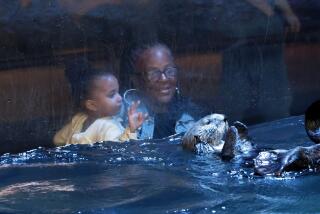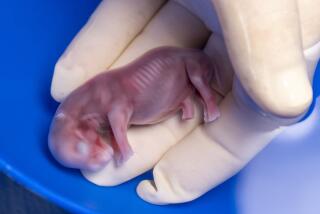Obstetrician Goes to the Apes With His Fertility Techniques : Medicine: UCI doctor travels to zoos to take on a new breed of patient--the female lowland gorilla.
- Share via
LONG BEACH — After nearly 10 years of helping infertile women become pregnant, UC Irvine obstetrician Bill Yee has turned his talents to an unusual breed of patient--the female lowland gorilla.
For the last two years, Yee has journeyed to zoos in Denver, Colorado Springs, Colo., and Oklahoma City to treat middle-aged gorillas with the high-tech fertility techniques he normally uses on women.
So far, no pregnancies have resulted. But Yee, director of Long Beach Memorial Medical Center’s in vitro fertilization program, tried again over the past weekend at the Oklahoma City Zoo. He retrieved eggs from a 32-year-old gorilla named Boma, fertilized them and froze the resulting embryo for implantation later in another large ape.
Yee is one of perhaps eight fertility specialists across the nation who are working with zoo veterinarians to assure that gorillas will survive. “This is not done for experimental reasons,” stressed the obstetrician, who volunteers his time. “We’re doing this to help propagate the species.”
Gorillas are “highly endangered,” with 15,000 to 50,000 lowland gorillas remaining in the rain forests of Western Africa, and an additional 300 in North American zoos, said Lester Fisher, the gorilla “species survival” chairman for the American Assn. of Zoological Parks and Aquariums. In addition, a “fragile” population of 280 mountain gorillas (the ones studied by naturalist Dian Fossey) live in Rwanda, Zaire and Uganda, but to date, no mountain gorilla has survived in captivity.
Ironically, zoos once contributed to the decline of gorillas, Yee and Fisher said. “In earlier years, in order to get the babies of the great apes, many times the mother would be killed” so poachers could net her baby gorilla for export to zoos eager for the animals, Fisher said.
But since 1980, the association’s 160 U.S. and Canadian zoos have stopped taking gorillas from the wild, focusing instead on captive breeding--and lately, high-tech fertility techniques.
The zoos have done hormone studies of gorillas, plotting the optimum time to introduce a female gorilla to her mate. They have learned that gorillas like to choose their partners.
And, because veterinarians lack the expertise, zoos have called on obstetricians to try human fertility techniques such as artificial insemination, in vitro fertilization and a technique called GIFT. (For in vitro, an egg is surgically removed, fertilized in the lab, and the embryo then implanted in the womb. In GIFT--gamete intra-Fallopian transfer--mature eggs are removed, then injected along with sperm into the Fallopian tubes where fertilization would occur naturally.)
The result? Although the GIFT technique has not yet been successful in gorillas, in recent years there have been more births than deaths, Fisher said. “There’s a thin line to reproduction, to stay on the positive side of the ledger,” Fisher said.
Since 1988, Yee has been helping zoos stay on the plus side of that “thin line.” In January of that year, he spoke to scientists and zoo veterinarians in a group called Great Apes about his specialty, in vitro fertilization. Soon afterward, he got a call from the Dallas Zoo.
“They had a female gorilla with ovarian cancer. They had to operate on her but they wondered if there was any chance if they could retrieve some eggs, fertilize them, cryo-preserve (freeze) them,” Yee said. He figured it could be done. Gorillas are huge, but “the basic anatomy and physiology is the same” as for humans.
Yee’s schedule was full, so UCI assistant professor of obstetrics Gregory Rosen retrieved five or six eggs from the ailing gorilla. He transferred them to another female gorilla, but no pregnancy resulted.
Later that year, Yee got another call, from the Cheyenne Mountain Zoo in Colorado Springs, Colo. Could he help an aging gorilla named Becky conceive? Yee offered to try.
He prescribed the drug Pergonal to stimulate her egg production. (Becky’s medication, ordinarily administered by injection, was given by dart gun for 10 days, Yee said; no one wants to get too close to an active, 200-pound gorilla.)
Yee then retrieved sperm from a male gorilla at the Denver Zoological Gardens 60 miles away, drove with it to Colorado Springs and, in a 30-minute operation--with his gorilla patient anesthetized and draped--he surgically implanted the sperm and one mature egg in one of Becky’s Fallopian tubes. Again, unfortunately, no pregnancy resulted. Yee said he tried unsuccessfully two more times to help Becky get pregnant.
In April, Yee tried again with Boma, the 32-year-old gorilla owned by the Oklahoma City Zoo. Again he prescribed Pergonal, and again he tried to help her conceive, using the GIFT technique. Again no luck.
His weekend effort will be Yee’s last with Boma. The gorilla has cervical cancer, Yee said, and after he retrieves her eggs--for implantation in another gorilla who might become a “surrogate mother”--another obstetrician will perform a hysterectomy.
There are some drawbacks to doing fertility work with gorillas, Yee noted. “They have a real distinct smell--an odor that you cannot describe” that is overpowering. So “you would not want to be in the same room for a long period of time with a gorilla.” And when you operate on one, he said, “you really have to take a shower afterwards.”
Also, when you want to examine one of these large, hairy patients, “you can’t instruct a gorilla: ‘Lie down and let me see how your ovaries are,’ ” Yee joked.
Rather, Yee has to guess the right time that her eggs are likely to be mature and ready to retrieve. And since gorillas must be anesthetized for each of these fertility procedures, it’s often a long time between his zoo visits, Yee noted. Given the risks of anesthesia, the gorillas are usually immobilized only at their annual physical exams.
But if his efforts so far have not produced a baby gorilla, Yee vows to keep trying. At Long Beach Memorial and UCI Medical Center in Orange, GIFT produces a pregnancy 27% of the time. So “we can do it,” Yee said. “It’s a matter of time.”
It is also a matter of urgency. “In human fertility work, the mother and father’s motive is to have a baby of their own,” Yee said. But “in developing baby gorillas, it’s to maintain their genetic identity in the gorilla world.” And if doctors and veterinarians cannot produce offspring from a gorilla such as Boma, her genetic material, he said, “will be lost forever.”






